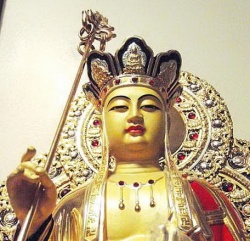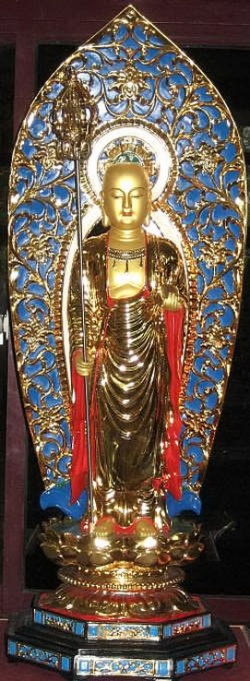Lotus Sutra of the Wonderful Law
Lotus Sutra of the Wonderful Law
妙法蓮華経 (Skt Saddharma-pun-darika-Sutra; Chin Miao-fa-lien-hua-ching; Jpn Myoho-renge-kyo )
Also known as the Sutra of the Lotus of the Wonderful Law or the Sutra of the Lotus Blossom of the Fine Dharma. A Chinese translation of the Sanskrit scripture Saddharma-pundarika-Sutra, known in English as the Lotus Sutra, produced by Kumarajiva in 406. It consists of eight volumes and twenty-eight chapters. Six Chinese translations are recorded as having been made of the Saddharma-pundarika-Sutra, three of which survive today. Among these, Kumarajiva's Lotus Sutra of the Wonderful Law is by far the most popular and is the basis of the T'ient'ai teachings that spread in China and Japan. Nichiren (1222-1282) also regarded the Lotus Sutra of the Wonderful Law as the best of the Chinese translations.
The titles of the twenty-eight chapters are (
1) Introduction,
(2) Expedient Means,
(3) Simile and Parable,
(4) Belief and Understanding,
(5) The Parable of the Medicinal Herbs,
(6) Bestowal of Prophecy,
(7) The Parable of the Phantom City,
(8) Prophecy of Enlightenment for Five Hundred Disciples,
(9) Prophecies Conferred on Learners and Adepts,
(10) The Teacher of the Law,
(11) The Emergence of the Treasure Tower,
(12) Devadatta,
(13) Encouraging Devotion,
(14) Peaceful Practices,
(15) Emerging from the Earth,
(16) The Life Span of the Thus Come One,
(17) Distinctions in Benefits,
(18) The Benefits of Responding with Joy,
(19) Benefits of the Teacher of the Law,
(20) The Bodhisattva Never Disparaging,
(21) Supernatural Powers of the Thus Come One,
(22) Entrustment,
(23) Former Affairs of the Bodhisattva Medicine King,
(24) The Bodhisattva Wonderful Sound,
(25) The Universal Gateway of the Bodhisattva Perceiver of the World's Sounds,
(26) Dharani,
(27) Former Affairs of King Wonderful Adornment, and
(28) Encouragements of the Bodhisattva Universal Worthy.
The Sutra opens with Shakyamuni Buddha and an assembly of his countless listeners gathered on Eagle Peak. The "Introduction" (first) chapter through the first half of the "Treasure Tower" (eleventh) chapter is set on Eagle Peak. The latter half of the "Treasure Tower" chapter through the "Entrustment" (twentysecond) chapter describes the so-called Ceremony in the Air in which the entire gathering is suspended in space. Finally, the "Medicine King" (twenty-third) chapter through the "Encouragements" (twenty-eighth) chapteris set again on Eagle Peak. These divisions are referred to as the "two places and three assemblies."
In The Words and Phrases of the Lotus Sutra, T'ient'ai (538-597) divided the Lotus Sutra of the Wonderful Law into two parts: the first fourteen chapters, which he called the theoretical teaching, and the latter fourteen chapters, which he called the essential teaching. The theoretical teaching takes the Form of preaching by the historical Shakyamuni)] who is depicted as having first attained Enlightenment during this lifetime in India. The essential teaching takes the Form of preaching by The [[Buddha who discards his transient role as the historical Shakyamuni and reveals his true identity as The Buddha who actually attained Enlightenment in the unimaginably remote past.
In the theoretical teaching, The Buddha declares that the Three Vehicles—the teachings for voice-hearers, cause-Awakened ones, and Bodhisattvas stressed in the pre-Lotus Sutra teachings—are not ends in themselves but only means to lead people to the one supreme vehicle of Buddhahood. T'ient'ai defines this revelation, known as the "replacement of the Three Vehicles with the one vehicle," to be the principal Doctrine of the theoretical teaching. This Doctrine is first revealed in the "Expedient Means" (second) chapter, which T'ient'ai regards as the principal chapter of the theoretical teaching. This chapter reveals "the true aspect of all Phenomena," indicating theoretically that there is no essential difference between an ordinary person of the nine worlds and a Buddha, and that the potential for Enlightenment exists in everyone. The chapter further clarifies this by declaring that all Buddhas appear in the World for one reason alone: to expound the one Buddha vehicle, that is, to enable all people to attain the Buddha wisdom. In the ensuing chapters up until the "Prophecies" (ninth) chapter, Shakyamuni explains the same idea through the parable of the three carts and the burning house and by revealing the connections he formed with his disciples in the distant past. Thus three times he explains the teachings—elucidating the principle, parable, and connections respectively—and each time one of the three groups of his voice-hearer disciples, groups of progressively lesser capacity, understands, and he in turn pronounces prophecies of their Enlightenment.
The remaining five chapters of the theoretical teaching refer to the time after Shakyamuni Buddha's Death and the propagation of the Lotus Sutra in that period. The "Teacher of the Law" (tenth) chapter explains both the difficulty and the great benefit of propagating the Sutra, and the "Treasure Tower" (eleventh) chapter describes The Buddha urging the Bodhisattvas present to spread the Sutra after his Death. The "Devadatta" (twelfth) chapter illustrates dramatically the principle that all people can equally attain Buddhahood. It does this with the examples of the enlightenment of Devadatta, an Evil man, and the Dragon King's daughter, a woman in reptile Form. In the "Encouraging Devotion" (thirteenth) chapter, the assembled Bodhisattvas respond to The Buddha's earlier call and vow to propagate the Sutra in the face of any obstacles that will occur after his Death. The "Peaceful Practices" (fourteenth) chapter sets forth the four peaceful practices to be employed in propagating the Sutra. This concludes the theoretical teaching.
The essential teaching begins with the "Emerging from the Earth" (fif-teenth) chapter. The most important Doctrine in the essential teaching, T'ient'ai says, is the revelation of Shakyamuni Buddha's original Enlightenment in the remote past. Though explicitly stated in the "Life Span" (sixteenth) chapter, the whole process of this revelation begins with the latter half of the "Emerging from the Earth" chapter, continues through the entire "Life Span" chapter, and ends in the first half of the "Distinctions in Benefits" (seventeenth) chapter. T'ient'ai terms this part of the Sutra the "one chapter and two halves" and regards it as the core of the Lotus Sutra. At the beginning of the "Emerging from the Earth" chapter, countless Bodhisattvas of the Earth appear, and Bodhisattva Maitreya addresses The Buddha, asking by whom these Bodhisattvas were taught. Shakyamuni replies that they are his original disciples whom he has been teaching since long ago. This revelation T'ient'ai terms "opening the near and revealing the distant in concise Form." The latter half of the chapter begins with Maitreya's second question: How could Shakyamuni possibly have trained all these Bodhisattvas in the mere forty-odd years since his Enlightenment? This opens the way for The Buddha's revelation in the "Life Span" chapter in which he discloses that he actually attained Enlightenment in the inconceivably distant past. This revelation T'ient'ai terms "opening the near and revealing the distant in expanded Form." The Buddha then describes in some detail the magnitude of the time that has elapsed since his Enlightenment, a period known as numberless major World system dust particle kalpas. Ever since this original Enlightenment, Shakyamuni says, he has been always in this saha World, appearing as Buddhas of different names and using various expedient means to teach and convert the people. The first half of the "Distinctions in Benefits" chapter describes the distinct benefits obtained by those who listened to The Buddha's description of his immeasurable Life span.
The latter half of the "Distinctions in Benefits" chapter and the final eleven chapters are concerned with the propagation of the Sutra after Shakyamuni's Death. The portion of the Sutra from the latter half of the "Distinctions in Benefits" chapter through the "Never Disparaging" (twentieth) chapter urges that the Sutra be propagated and declares the benefits of doing so. The "Supernatural Powers" (twenty-first) and "Entrustment" (twentysecond) chapters describe Shakyamuni Buddha's transfer of the Sutra respectively to the Bodhisattvas of the Earth in particular and to all the Bodhisattvas in general. The remaining six chapters further stress the necessity and benefits of propagation.

